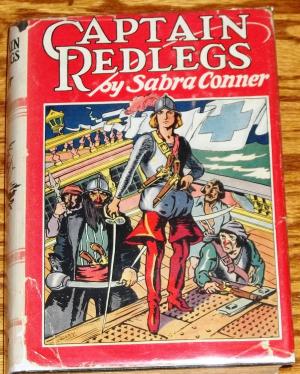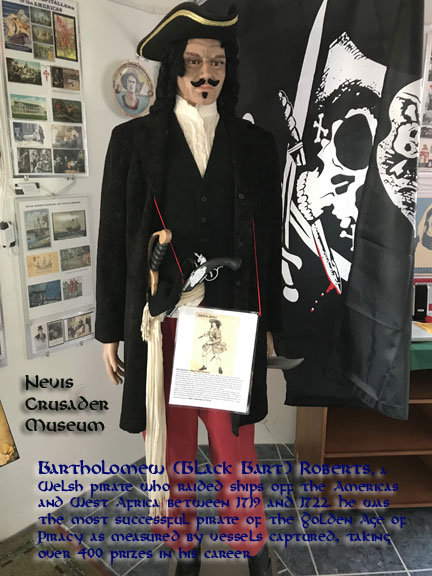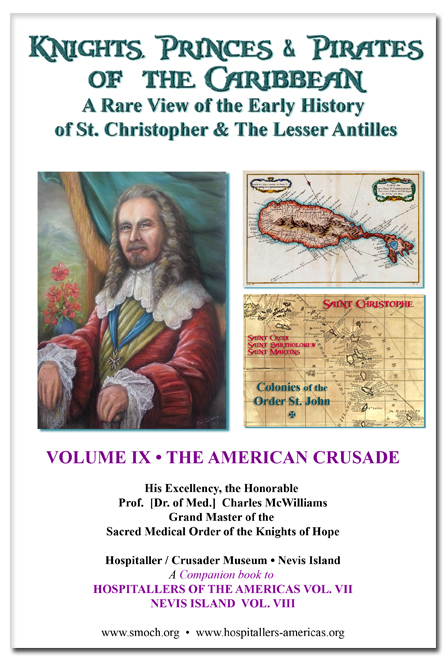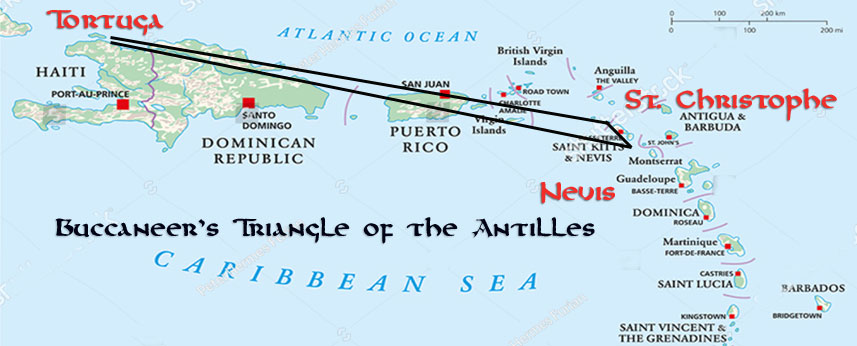BUCCANEER'S & PIRATES OF NEVIS
by Msgr., Hon. Prof., Dr. of Med. Charles McWilliams
• Grand Master of the Sacred Medical Order of the Knights of Hope (Antillean Order of St. John) - Ecuador • Nevis • Puerto Rico • Florida • Curacao
Buccaneers vs. Pirates
For most people the word pirate conjures up images of high seas adventurers and ruthless criminals, stereotyped from the Golden Age of Piracy, a short period from roughly 1690-1730 when pirates such as Blackbeard Teach, "Black Bart" Roberts, Charles Vane, and "Black Sam" Bellamy sailed the seas.
These highly romanticized images are the result of decades of paperbacks and Hollywood movies. In reality, the buccaneers were shaped by needs for survival, privateers were mercenary sailors, often gentleman and some Knighted by their monarch, and many pirates of the Golden Age were ruthless, often engaging in violence and savage acts. Like all pirates, most of these men (and sometimes women) belonged to no nation, and answered to no law other than their own code of conduct. However, due to the early lawlessness of the Caribbean after Christopher Columbus set foot on land, it is best to examine the individual lives of each character, and characters they were, in order to make a balanced viewpoint.
Buccaneer's Triangle |
Local history on Nevis pays scant attention to the fact that Antillean piracy was spawned on Nevis, St. Christophe, and Tortuga. Nevis and Tortuga, small islands of little economic importance to the Spanish, made for pirate havens. It actually began as buccaneers, who simply were struggling for survival. But as sailng methods and ships improved, the buccaneers honed their skills towards the gold and silver being transported from Latin America back to Spain. In other words, from buccaneering for survival, piracy and privateering turned into a mercenary style profession.
To boot, to offset the piracy over vast oceans they had little control, the Monarch's would recruit mercenaries (often the same people), pirates, even slaves, and brand them 'privateers' and give them a license to loot, called the 'letter of marque.' Like today's bail bondsmen, they could sail the waters, and anything was game as long as the flagship of the loot was not the country of origin. Naturally, there was least controls over the open seas so anything was game, and anything could happen. |
Least known is the fact that Captain KIdd began his career on Nevis. By 1689, Kidd was a member of a French-English pirate crew sailing the Caribbean under Captain Jean Fantin. During one of their voyages, Kidd and other crew members mutinied, ousting the captain and sailing to the British colony of Nevis. There they renamed the ship Blessed William, and Kidd became captain either as a result of election by the ship's crew, or by appointment of Christopher Codrington, governor of the island of Nevis. In any case, Captain Kidd, an experienced leader and sailor by that time and the Blessed William, became part of Codrington's small fleet assembled to defend Nevis from the French, with whom the English were at war, as well as the Spanish and Arawaks.
 |
Captain "GREAVES,alias "Red Legs, was born in Barbados of Irish prisoners who had been sent there as slaves by Cromwell. Most of these slaves were natives of Scotland and Ireland, and, owing to their bare knees, generally went by the name of Red Legs. Finding his calling of piracy, Greaves became very efficient, and quickly rose to eminence.He was remarkable for his dislike of unnecessary bloodshed, torture of prisoners, and kiling of non-combatants.These extraordinary views brought about a duel between himself and the evil Captain Hawkins, in which he was victorious in a fight, and he was at once elected commander of the ship, the pirate's code. Greaves now entered a period of the highest piratical success, but always preserved very strictly his reputation for humanity and morality.He never tortured his prisoners, nor ever robbed the poor, nor maltreated women. His greatest success of all was his capture of the Island of Margarita, off the coast of Venezuela. On this occasion, after capturing the Spanish Fleet, he turned the guns of their warships against the forts, which he then stormed, and was rewarded by a huge booty of pearls and gold. Red Legs then retired to the respectable life of a planter on the Island of Nevis, but was one day denounced as a pirate by an old seaman. He was taken to Port Royal in Jamaica, andcast into a dungeon to await execution, when the great earthquake came which destroyed and submerged the whole town in 1680, and one of the few survivors was Greaves. He was picked up by a whaler, on board of which he served with success, and later on, for his assistance in capturing a gang of pirates, he received pardon for his earlier crimes. He again returned to a plantation on Nevis, and was noted for his many acts of piety and for his generous gifts to charity, eventually passed of old age, universally respected and cherished. Probably our first national hero of Nevis was Red Legs. |
 |
Bartholomew Roberts (1682–1722) was a Welsh pirate who raided ships off the Americas and West Africa between 1719 and 1722. He was the most successful pirate of the Golden Age of Piracy as measured by vessels captured, taking over 400 prizes in his career. He is also known as Black Bart, but records show this name was never really used in his lifetime. In 1719 Roberts was a sailor serving as third mate on the slave-ship Princess, when she was captured by pirates off the Gold Coast. The raiders were led by Hywell Davis, and a reluctant Roberts was press-ganged into joining the pirate crew. It was on Davis' ship the Royal Rover that they sailed to Principe with the intention of taking the Portuguese governor for ransom. The plot was discovered and Davis was ambushed and killed. The pirates regrouped, attacked and plundered the island, in revenge for Davis' death and then sailed for Brazil, capturing countless ships and much booty. On his new ship, the Fortune, Roberts even instigated a pirate code, sworn on a Bible, setting out rules and regulations for their conduct.
Back in the Caribbean, Roberts carried on raiding but eventually came across stiff resistance in the form of two well-armed ships from Barbados. Severely damaged, the Fortune, limped to Dominica for repairs. Rumors that pirates who had taken advantage of the 1698 royal pardon were on surrendering denied the benefits of the pardon only increased mistrust and antagonism; the pirates resolved "no longer to attend to any offers of forgiveness but in case of attack, to defend themselves on their faithless countrymen who may fall into their hands." In 1722 Captain Luke Knott was granted £230 for the loss of his career, after turning over 8 pirates, "his being obliged to quit the Merchant service, the Pirates threatening to Torture him to death if ever he should fall into their hands." It was by no means an empty threat - in 1720 pirates of the crew of Bartholomew Roberts "openly and in the daytime burnt and destroyed... vessels in the Road of Basseterre [St. Kitts] and had the audaciousness to insult H.M. Fort," avenging the execution of "their comrades at Nevis". |
Black Bart Roberts then sent word to the governor that "they would Come and Burn the Town [Sandy Point] about his Ears for hanging the Pyrates there." Roberts even had his own pirate flag made showing him standing on two skulls labeled ABH and AMH - 'A Barbadian's Head' and 'A Martinican's Head' - later that same year he gave substance to his vendetta against the two islands by hanging the governor of Martinique from a yardarm. As bounties were offered for the capture of pirates, the pirates responded by offering rewards for certain officials. And when pirates were captured or executed, other pirate crews often revenged their Brethren of the Coast, attacking the town that condemned them, or the shipping of that port. This sort of solidarity shows that there had developed a real pirate community, and that those sailing under 'the banner of King Death' no longer thought of themselves as English or Dutch or French but as Pirates of the Republic. (From the book: Nevis Island, Its Early History).
 |
You can read all about this fascinating history in the author's book: KNIGHTS, PRINCES & PIRATES OF THE CARIBBEAN
|
The Hospitaller colonization of the Americas occurred during a 14-year period in which the Knights of St. John (Knights of Malta) possessed four Caribbean islands: Saint Christopher, Saint Martin, Saint Barthélemy, and Saint Croix.
The Knights' presence in the Caribbean grew out of their order's close relationship with the French nobility and the presence of many members in the Americas as French administrators. The key figure in their brief colonization was Phillippe de Longvilliers de Poincy, who was both a Knight of St. John and governor of the French colonies in the Caribbean. Poincy convinced the Knights to purchase the islands from the bankrupt Compagnie des Îles de l'Amérique in 1651 and remained to govern them until his death in 1660. During this time, the Order acted as proprietor of the islands, while the King of France continued to hold nominal sovereignty. However, Sir Poincy ruled largely independent of them both. In 1665, the Hospitallers sold their rights in the islands to the new French West India Company, bringing their colonial project to an end.
The Antillean Order of St. John of St. Christopher/Nevis is the 21st century, fresh and first major impetus to present the medical corps history of the monastic/military orders, as best as it can be reconstructed of the medieval records, first recounted by Edgar Hume’s Medical Work of the Knights Hospitallers (1940). In this book, it will be seen that the Hospitaller Orders developed medicine, surgery, and nursing as an organized form of hospice and hospital care that sprang from the Ten Commandments, and from the Old and New Testaments, which has been one of the most stabilizing factors of peace in western culture. Many customs and accepted civilized behaviors like the manners of a gentleman, the respect for marriage, rules of engagement, diplomacy, etc. sprang from the Codes of Chivalry that so few recognize nor respect today.
Through the reemergence of the Antillean Sacred Medical Order of the Knights of Hope for the 21st century, a new chapter in their medical history is being developed. Incorporated as early as 2006, this Order has reemerged the Order of St. John in the Federation of St. Kitts/Nevis where it originally settled in 1639. A museum and Chapel has been constructed and formally opened to the public June of 2017 as testament to this rich and unique history. Many Goverment dignitaries of the islands are now members of this Sacred Antillean Order. The Knights Hospitallers are once again establishing itself as a functional order, dedicating itself to meeting the spiritual and medical needs of the poor and sick so they once again dedicate themselves to following the example and teachings of our Lord Jesus Christ.
In order to accomplish its goals, the Order has built on the traditions and foundations of over one thousand years of medical history in a modality called monastic medicine. The Order maintains a monastic medical center on Nevis which services more than 6,000 patients of the Leeward Islands. With his emphasis on the medical history of the Order, Grand Master, professor Charles McWilliams has provided the historical foundations in a series of seven books. With this seventh volume, we record the medical achievements and history of the Hospitallers of the Americas, providing heretofore an untold saga, as a unique reference for those studying the history of medicine, and the Christian orders that shaped ambulance care (the Red Cross and St. John Ambulance), surgery, hygiene, and natural medicine (naturopathy). All members of the Order are indeed grateful for the works and scholarly insights of Grand Master McWilliams. May the Knights Hospitallers continue to serve through its humanitarian actions, and may all our earthly endeavors be to glorify God.
Copyright 2017. The Sacred Medical Order - Knights of HOPE (SMOKH since 2006) • Worldwide
Privacy Policy | Terms of Use | Updated on Nov. 21, 2017
